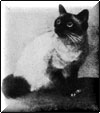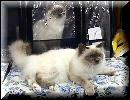The Legend of the Sacred Cat of Burma
(Birman)

The Following was Taken from a Passage in the book Cat in the Mysteries of Religion and Magic and was not altered with the exception of the added (Birman) to clarify. There have been a lot of questions as to how authentic any of this information is. Also it was the opinion of Russell Gordon that the Siamese was possibly descended from the Birman, which due to the total lack of evidence astounds us.
![]()
The Sacred Cat of Burmah (Birman) is yet more veiled in obscurity than its supposed descendant the Siamese, and we are indebted to Russell Gordon for the only authentic account of this species that has reached our shores. He gained his information during the Burmese War of 1885 whilst serving as an officer in the English Army occupying Burmah. His position enabled him to protect certain kittahs, or priests, whose lives were in danger, and in return they bestowed on him unprecedented privileges of entry into their secret and sacred places.
From his account we learn that the Indian Brahmins were the bitter enemies of the people of Khmer and their beloved kittahs. From the commencement of the eighteenth century they had mercilessly pursued and massacred these priests, who, to escape from their persecuting zeal, fled to North Burmah, where the mountains afforded security from pursuit. There, amid chaotic labyrinths and dizzy precipices, the indomitable kittahs founded the marvelous subterranean Temple of Lao-Tsun (the Abode of the Gods), and practiced the secret rites that were closed to all but the higher castes among their own people.
Gordon describes the Temple of Lao-Tsun, as " one of the greatest marvels of the East—situated to the East of Lake Incaougji, between Magaoung and Sembo, in an almost desert region of immense peaks and chaotic labyrinths, it offers a barrier of insurmountable walls. Here there still existed in 1898 the last kittahs (priests), and as a most extraordinary favour I was permitted to see and observe them and their sacred animals.
Following the rebellion and the English occupation, at the base of Bhamo (a base very isolated and distant from Mandalay), we had to protect the kittahs against a Brahmin invasion, and we saved them from certain massacre and pillage. Their Lama-kittah received me, and presented me with a plaque representing the Sacred Cat at the feet of a bizarre deity, whose eyes are made of two long sapphires (specimen "No. 4108 in my collection at Mildenhall), and after having shown me the sacred cats, in number about a hundred, explained their origin to me." This he did by relating the following beautiful legend :
![]()
" When, with the malevolent moon, the barbarian Siamese Thais came to the mountains of the Sun, Mun-Ha was living in the Temple of Lao-Tsun. Mun-Ha, the most precious among the most precious, for whom the god Song-Hio had woven the beard of gold. This venerable priest had ever lived in rapt contemplation of Tsun-Kyankse, the goddess with eyes of sapphire who presided over the transmutation of souls about to receive their dues, whose searching gaze none could evade. Mun-Ha had an oracle who dictated his decisions, and this was his cat Sinh, whom the kittahs fervently revered.
" Seated close to his dread master, Sinh lived in the contemplation of the goddess. The beautiful animal His eyes were yellow like gold from the reflection of the metallic beard of Mun-Ha, yellow like the amber body of the goddess with the sapphire eyes.
" One night, at the rising of the moon, the Thais menacingly approached the sacred Temple. Then, invoking destiny, Mun-Ha died, weighed down by years and anguish. He died in the presence of his goddess ; close beside him was his divine cat, and the kittahs lamented their cruel loss. But suddenly, the miracle of immediate transmutation took place. Sinh bounded on to the holy Throne. Supported on the head of his stricken master he faced the goddess. And the hair along his spine blanched to a golden hue. His eyes, golden of the gold of the beard woven by the god Song-Hio—his eyes changed to blue—immense, abysmal, sapphire—like to the eyes of the goddess. His four feet, brown as the earth, his four feet which contacted the venerable skull, whitened to the claws, to the toe-tips, thus purified by the touch of the puissant dead.
" Sinh turned towards the South Door, his imperious gaze, in which could be read an imperative order, possessed of an invincible force the kittahs obeyed. Then they closed on the ancestral enemy the bronze doors of the holy Temple, and passing by their subterranean tunnel they routed the profane invaders. " Sinh refused all nourishment, and would not quit his Throne. He continued standing erect and facing the goddess—mysterious priest—fixing his steadfast gaze on her eyes of sapphire, partaking' of their fire and sweetness.
" Seven days after the death of Mun-Ha, erect on his purified feet of white, without lowering an eyelash, he died. Thus was borne away towards Tsun-Kyankse the soul of Mun-Ha, which was too perfect for earth. But, for the last time, his look turned slowly towards the South Door
" Seven days after the death of Sinh the kittahs assembled before Tsun-Kyankse to choose the successor of Mun-Ha. Then —Oh wonder !—There came in slow procession the hundred cats of the Temple. Their feet were gloved in white ; their snowy hair emitted the reflection of gold, and the topazes of their eyes had changed to sapphires.
" The kittahs fell prostrate in an attitude of devout fear, and waited. Did they not know that the souls of their masters inhabited the harmonious forms of the sacred animals ? And these, solemn and grave, surrounded Legoa—the most youthful of the priests—and so revealed the will of Heaven. When a sacred cat dies in the temple of Lao-Tsun, the soul of a kittah re-enters—to quit no more—the mysterious paradise of Song-Hio, the god of gold. Unhappy are those who even involuntarily hasten the end of these formidable and venerable cats : the most dreadful torments are reserved for them, that the soul in pain may be appeased." (From the French of Marcelle Adam.)
![]()
Gordon, who does not relate this legend, in the remarks from which I have quoted, says of it, that " The legend is pretty but explains nothing scientifically. . . . One may feel assured that the Burmese (Birman) Cat is a very ancient race, but it will, I think, be impossible ever to obtain documentary evidence about a race so rare that no breeder or author in the two continents with whom I have corresponded within the last thirty years, has anything more than a sketch of them, and only knows them by the writings of Auguste Pavie and of myself."
Gordon describes the Burmese (Birman) cats as being much like the Siamese in colouring, but says they had white toes on all four feet, long hair, and magnificent bushy tails which they usually carried over their backs in squirrel fashion. Their eyes were intensely blue, deep and melancholy—gentle when at rest, but wild and fiery if angered.
![]()
Cat in the Mysteries of Religion and Magic
M. Oldfield Howey, Castle Books, 1956
![]()

Visit the Rest of Taron Birmans:
|
© Copyright 1996, 2009 Ronald & Nora Thayer, All Rights Reserved |




